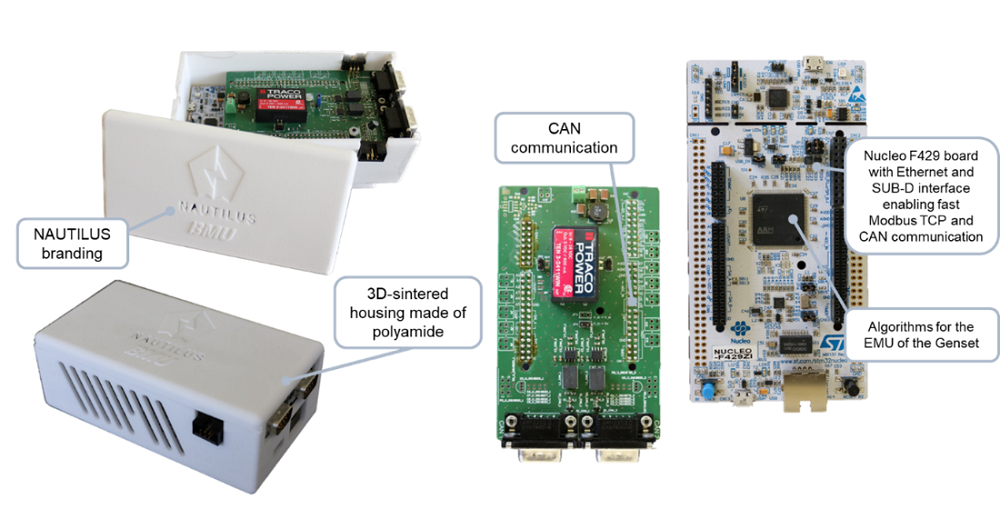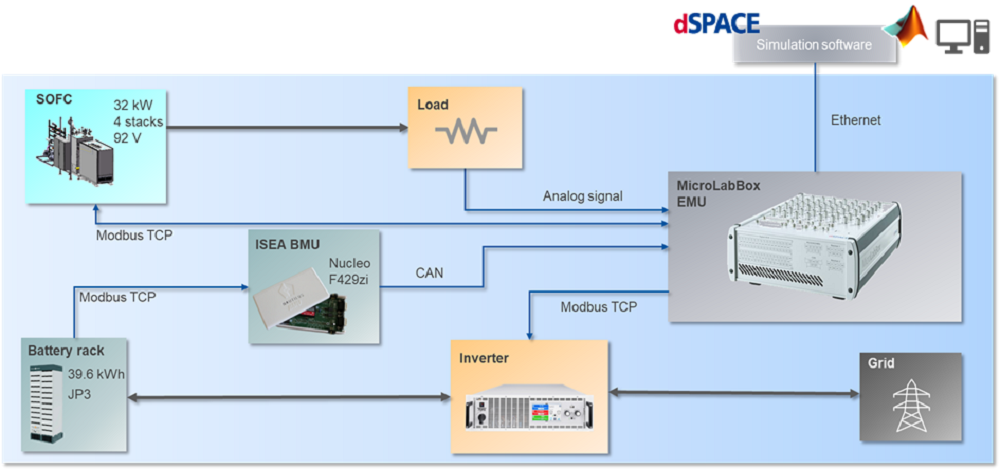A control strategy for the operation of the hybrid genset consisting of a solid oxide fuel cell system and battery system and its schematic grid connection is examined and developed in this work package. Specific objectives were the development of a Battery Management Unit (BMU) to operate the battery within a safe operation window, the development of a unitized control unit for the hybrid genset, which contains the control strategy to perform the energy management of the hybrid genset and the schematic integration with the cruise ship’s grid and the Internal Combustion Engine(s) (ICEs).
5.1 WP Leader
5.2 Tasks and Outputs
Battery management unit
- The Battery Management Unit (BMU) ensures that the battery is working within a safe operation window and provides information of the battery system for diagnosis and the control unit.
- The BMU is an important component of the Genset representing the central gateway between the battery rack system and the control unit. The BMU was implemented in all test bench variants realised within the NAUTILUS project.
- The algorithms of the BMU have been validated in software in the loop environment.

Figure 1: Battery Management Unit (BMU) developed for the NAUTILUs project and built-in hardware
- Deliverable D5.1 - Battery management unit from RWTH Aachen – completed
- Deliverable D5.2 - Final report on battery management unit – completed
Unitized control unit for hybrid genset
- The unitized control unit is a central component of the Genset and was implemented in all test bench variants. To enable dynamic operations, the hybrid genset needed an advanced control strategy that was developed by the project partners under the leadership of RWTH Aachen University. The strategy for energy management was developed to ensure an efficient and economical operation of the propulsion system considering stress factors that could lead to accelerated aging of its components and fuel economy. Hereby, conventional energy management methods, as well as machine-learning-based energy management methods were developed and validated in a hardware-in-the-loop testing environment. In order to make realistic assumptions, cruise ship power profiles were used for development and validation purposes.
- Tests on the PoC test bench with both components and the unitized control unit were completed.

Figure 2: Investigation of the battery and the battery management system within the NAUTILUS project
- The hardware setup and the signal routing in the Proof of Concept (PoC) test bench as shown below in Figure 3.

Figure 3: Proof of Concept (PoC) hardware setup
- Deliverable D5.3 - Unitized control algorithm for hybrid genset and 60 kWe demonstrator – completed
Integration with on-board grid and internal combustion engine (ICE)
- Within the scope of this the integration with on-board grid and ICEs was investigated. The shipyards (Meyer Werft and Chantiers de l'Atlantique) have provided information about the ship’s grid with the technical interfaces as well as cruise profiles for large 5000-passenger cruise ships and medium-sized 1000+-passenger cruise ships.
- RWTH Aachen University and Deutsches Zentrum für Luft – und Raumfahrt (DLR) developed the schematic integration into the ship’s grid on the basis of the topology which will be part of WP3 - Genset System Engineering & Proof of Concept and the developed demonstrators in WP6 - Functional Demonstrator.
- Deliverable D5.4 - Control interface and integration with electrical and thermal systems – completed
5.3 Duration and Status
- Months 1- 54
- Status – in progress
- MS3 - Control algorithm in real-time PC
5.4 WP5 Highlights
- Development of a battery management unit (BMU) enabling tailored signals to improve the controls of the hybrid propulsion system
- Embedding energy management algorithms in a real-time PC for the Proof of Concept (PoC) test setup to operate the hybrid propulsion system
- Verification of the functionality of the energy management algorithms in a simulative environment with parameterized propulsion component models. Read more in the paper: “A Data-Driven Approach to Ship Energy Management: Incorporating Automated Tracking System Data and Weather Information”
- Gathering information on ship's grid for the schematic grid integration of the unitized control unit
- Completion of the measurement series in the PoC test bench
- Performance evaluation of different energy management methods in the PoC test bench. Read more in the paper “Comparative analysis and test bench validation of energy management methods for a hybrid marine propulsion system powered by batteries and solid oxide fuel cells”
- Finalizing the schematic grid integration into a ship's grid with parameterized propulsion system models and real-time capable hardware to perform the energy management for a full-scale system
5.5 Next Steps
- Embedding the unitized control unit in the Demonstrator unit (October 2024).
- Performance evaluation of different energy management methods in the Demonstrator test bench.
Last updated: October 4th, 2024
